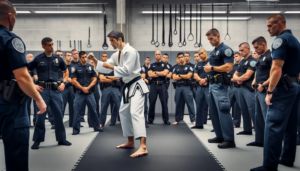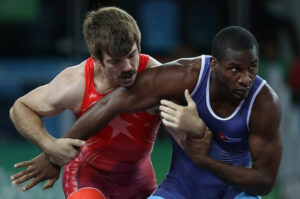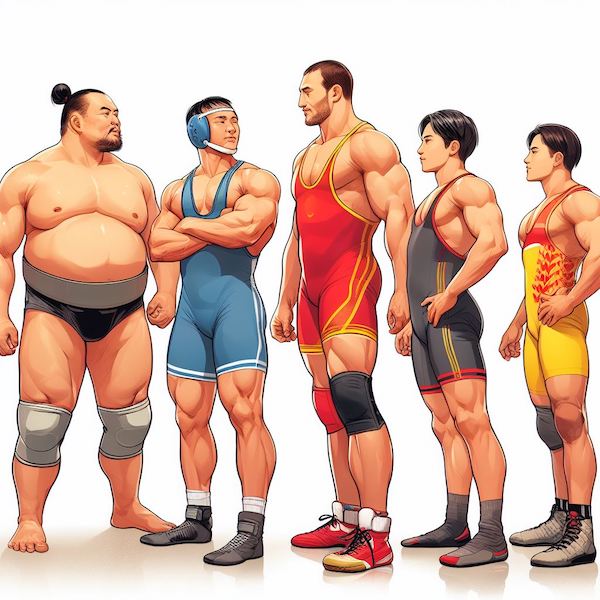
Are you wondering about the different wrestling styles that are most popular in 2023 and beyond?
In this article, we’ll look at 15 different wrestling styles that are popular today by going through their date and country of origin, the main techniques used, where they’re popular, and what makes them unique.
Contents
- Different Types of Wrestling
- 1. Shuai Jiao
- 2. Kurash (Uzbek Wrestling)
- 3. Pankration
- 4. Ssireum
- 5. Sumo Wrestling
- 6. Glima (Scandinavian Wrestling)
- 7. Mongolian Wrestling (Bökh)
- 8. Greco-Roman Wrestling
- 9. Lucha Libre
- 10. Catch Wrestling
- 11. Freestyle Wrestling
- 12. Folkstyle Wrestling (Collegiate Wrestling)
- 13. Professional Wrestling
- 14. Sambo
- 15. Beach Wrestling
Different Types of Wrestling
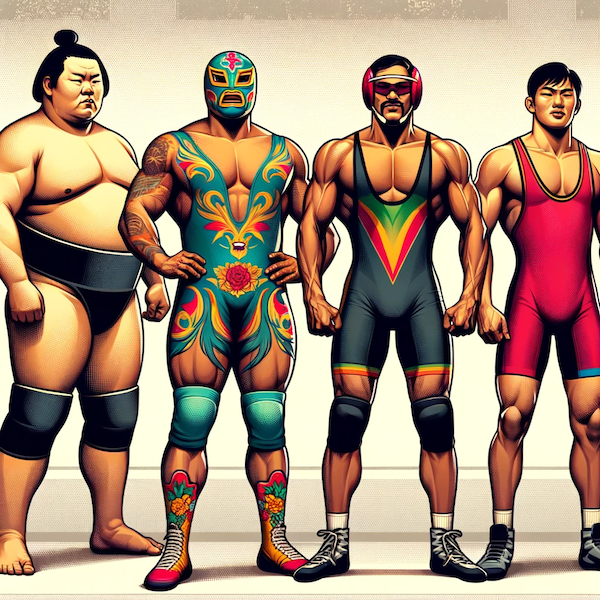
There are more than 60 different wrestling styles today, which is unsurprising as wrestling dates back over 15,000 years to the Upper Paleolithic period.
In 2023, the most popular wrestling styles are folkstyle wrestling, Greco-Roman wrestling, freestyle wrestling, professional wrestling, folk wrestling, sumo wrestling, and catch wrestling.
In origin order, let’s take a closer look at the 15 different wrestling styles that are most popular in 2023.
1. Shuai Jiao

- Origin: 2,697 BC, Ancient China
- Main Techniques: Throws, takedowns, sweeps
- Popularity: China, with some international practitioners
Shuai Jiao has its roots entwined in ancient Chinese history and is revered as one of the oldest forms of wrestling in the world.
This martial art, which emphasizes swift throws and agile footwork, is a testament to the combat techniques of China’s ancestral warriors.
It’s a discipline where the harmony of momentum and balance supersedes brute force, reflecting a philosophy deeply ingrained in Chinese culture.
Shuai Jiao translates to throwing and tripping and is practiced while wearing a jacket similar to that used in judo, known as Da Lian.
This attire is integral to the sport, as it allows for a variety of grip techniques essential for executing its dynamic throws.
Practitioners, or shuaijiaoshou, engage in a dance of combat, seeking to off-balance their opponent with a combination of takedowns, joint locks, and blocks.
Shuai Jiao’s lineage can be traced back to the imperial guard of successive Chinese dynasties, where it was honed as a means of battlefield defense.
Today, it’s celebrated not only for its rich historical tapestry but also for its practical application in self-defense.
The sport has evolved with standardized rules and is a staple in Chinese military and police training, yet it retains the traditional elements that connect modern practitioners with their illustrious past.
2. Kurash (Uzbek Wrestling)
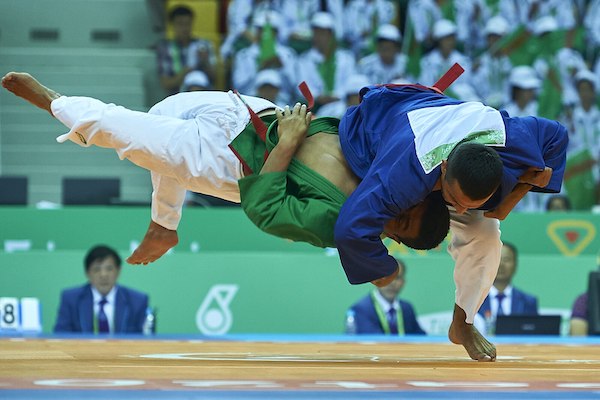
- Origin: 1,300 BC, Uzbekistan
- Main Techniques: Throws, sweeps, and trips
- Popularity: Central Asia, with growing international participation
Kurash is a traditional form of wrestling with its roots in Central Asia, particularly in Uzbekistan.
The term Kurash is derived from a Turkic word meaning wrestling, and the sport is practiced in various forms across Central Asian countries.
The wrestlers, known as Köräş wrestlers in some regions, use towels to hold their opponents, aiming to throw them off their feet.
The rules of Kurash are designed to reward high amplitude throws, with the ultimate goal being to throw the opponent on their back with full control, force, and speed. This is known as a Halal, and achieving it results in winning the fight.
There are also points awarded for throws that are close to a Halal, known as Yonbosh, and lesser points for throws close to Yonbosh, called Chala.
The sport emphasizes respect and sportsmanship, with penalties in place for infractions, and matches beginning with a salutation called Ta’zim.
Internationally, Kurash is governed by the International Kurash Association (IKA), which was founded in 1998 and has been holding championships since 1999.
3. Pankration
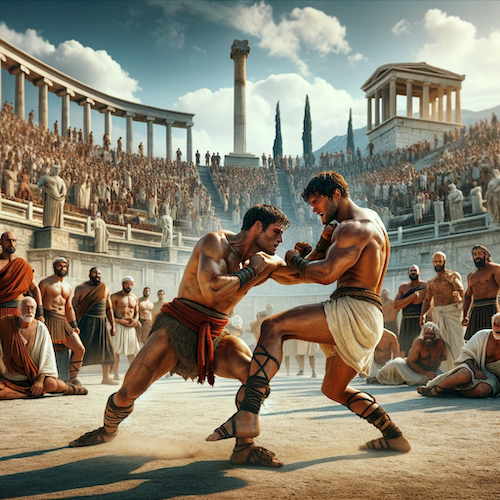
- Origin: 648 BC, Ancient Greece
- Main Techniques: Striking, grappling, submissions
- Popularity: Greece, with modern adaptations practiced worldwide
Pankration is an ancient Greek martial art, recognized as one of the earliest forms of mixed martial arts due to its debut in the Olympic Games of 648 BC.
This formidable combat sport was renowned for its minimal rules and the integration of boxing and wrestling techniques, allowing strikes, kicks, holds, and joint locks.
Its name translates to ‘all power’ and reflects the unrestricted nature of the competition, where only biting and eye-gouging were forbidden.
In its original form, pankration was a testament to physical prowess and strategic combat, often resulting in severe injury or even death, as the absence of time limits or weight classes made contests particularly brutal.
The sport’s emphasis on grappling made skilled wrestlers dominant figures, much like in modern MMA.
Modern pankration, however, has been adapted to prioritize safety while maintaining the spirit of versatility and adaptability.
It has been resurrected with a focus on controlled techniques, protective gear, and regulated competition, bridging the gap between its storied past and its place in contemporary martial arts.
4. Ssireum
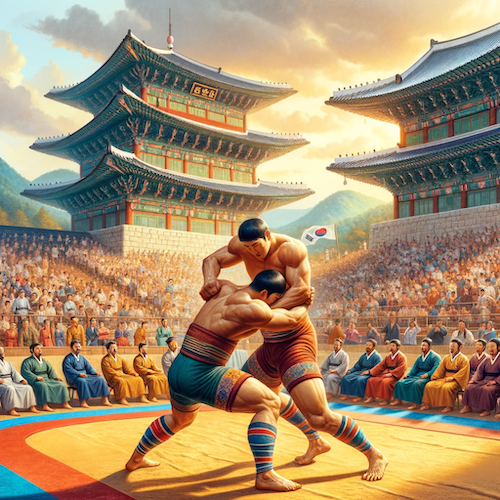
- Origin: 37 BC – 668 AD, Goryeo Dynasty, Korea
- Main Techniques: Leg trips, body throws, strength-based grappling
- Popularity: South Korea, with efforts to gain international recognition
Ssireum, or Korean wrestling, is a traditional national sport of Korea with its origins tracing back to the first century.
In modern Ssireum, competitors wear a belt called a satba, which wraps around the waist and thigh, and the goal is to bring any part of the opponent’s body above the knee to the ground.
This sport is deeply embedded in Korean culture, often associated with festivals and holidays, and has even been recognized by UNESCO as an intangible cultural heritage, shared by both South and North Korea.
Ssireum is conducted within a circular ring with a diameter of approximately 7 meters, filled with sand.
Matches begin with the wrestlers kneeling and gripping each other’s satba, then rising to commence the bout.
Victory is achieved by bringing the opponent to the ground at knee level or higher.
Unlike sumo, pushing an opponent out of the ring does not result in a win but prompts a restart.
Professional Ssireum matches are typically best out of three, overseen by a chief referee inside the ring and sub-referees outside.
5. Sumo Wrestling
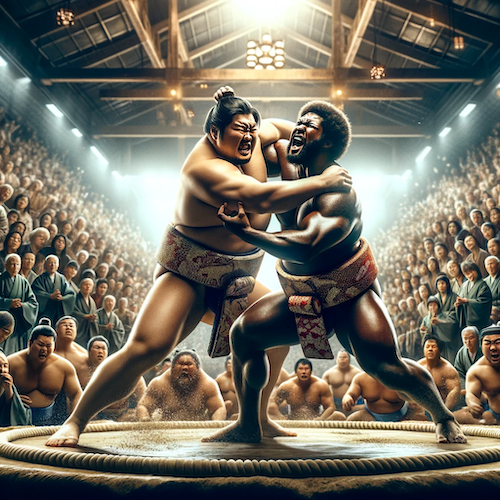
- Origin: Kofun period (300–538 AD), Japan
- Main Techniques: Pushing, throwing, forcing out of the ring
- Popularity: Japan, with growing interest globally
Sumo wrestling, Japan’s national sport, is a revered martial art showcasing a blend of size, skill, and enduring spirit.
Rikishi, the sumo wrestlers, engage in a full-contact battle within a circular ring, aiming to eject their opponent from this space or compel any part of their body, other than the soles of their feet, to touch the ground.
Characterized by its rich ceremonial traditions, sumo is deeply embedded in Japanese culture, yet it captivates a global audience.
Sumo wrestlers often exceed 300 pounds and train rigorously in specialized sumo schools, honing their agility and technique despite their huge builds.
Before the match begins, sumo wrestlers engage in a traditional shiko, a ritual dance intended to purify the ring and showcase their balance and power.
Sumo’s ancient roots trace back centuries, yet it remains a modern spectacle of martial prowess, maintaining its historical rites while evolving as a competitive sport.

- Origin: 793–1066, Viking Age, Scandinavia
- Main Techniques: Throws, locks, and trips
- Popularity: Iceland, Scandinavia
Glima is a traditional form of Nordic folk wrestling that encompasses several styles, practiced both as a sport and a form of combat.
Originating from the early Norwegian settlers in Iceland, it has been a part of Icelandic culture since at least the 13th century, according to the Jónsbók law book.
The most common form of Glima in Iceland, known as trouser-grip wrestling or brókartök, emphasizes technique over brute strength.
Competitors wear special belts around the waist and thighs, which are used to grip and execute various throws and trips.
The goal is to make the opponent touch the ground with any part of the body between the elbow and the knee.
Glima is distinct from other wrestling forms in several ways:
- Wrestlers must always stand erect.
- They step clockwise around each other to create offensive and defensive opportunities.
- Forceful pushing or knocking down isn’t permitted.
- Wrestlers should maintain eye contact over each other’s shoulders, relying on touch and feel rather than sight.
The sport is governed by a code of honor called drengskapur, which emphasizes fairness, respect, and the safety of training partners.
7. Mongolian Wrestling (Bökh)
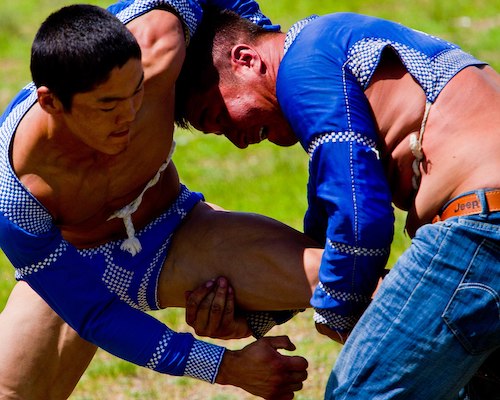
- Origin: Early 13th century, Mongolia
- Main Techniques: Balance disruption, throws, leg trips
- Popularity: Mongolia, with some international interest
Mongolian wrestling, or Bökh, is a revered cultural sport that traces its origins to the legendary warrior heritage of Mongolia.
It’s more than a display of physical prowess; it’s a ceremonial practice deeply embedded in the nation’s identity, often featured in the grand Naadam Festival, which showcases the Three Manly Skills of archery, horse racing, and wrestling.
Bökh competitors, known as bökhchins, don traditional attire called zodog (a jacket), shuudag (shorts), and gutal (boots), symbolizing the valor of ancient warriors.
The goal is to bring the opponent to the ground with any part of the body other than the feet.
There are no weight classes, making technique, balance, and leverage as crucial as strength.
Matches take place on open ground, highlighting a connection to the earth and the elements, with no time limits, allowing bouts to unfold with a blend of strategy and endurance.
The wrestlers perform the “Eagle Dance” (Devekh), mimicking the flight of the mythical Garuda, before and after each match, signifying honor and readiness.
The sport’s techniques are vast, with over 700 named moves, many of which are taught from a young age, reflecting the importance of Bökh in shaping the physical and moral fiber of Mongolian youth.
8. Greco-Roman Wrestling
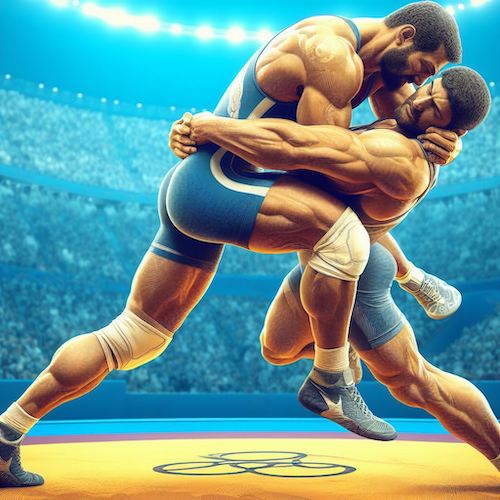
- Origin: Early 19th century, France
- Main Techniques: Upper-body throws, locks, and grips
- Popularity: Worldwide, especially in Europe and Olympic-participating countries
Greco-Roman wrestling is a wrestling style with deep historical roots, characterized by its strict focus on upper-body techniques.
It was created in imitation of classical Greek and Roman representations of the sport and was established as an Olympic sport in 1896.
Greco-Roman wrestling prohibits holds below the waist, channeling wrestlers into a battle of throws, locks, and hand-fighting skills.
Wrestlers must rely on upper-body strength and intricate grips to outmaneuver their opponents, making for a powerful display of control and precision.
Wrestlers in this style are known for their exceptional core and arm strength, as they execute a variety of lifts, body slams, and throws without the assistance of leg attacks.
Points are awarded for controlling the opponent, successful throws, and pinning the opponent’s shoulders to the mat.
Greco-Roman wrestling’s emphasis on raw power and technique makes it a unique and challenging discipline, maintaining its status as a staple in international wrestling competitions, including the Olympics.
9. Lucha Libre

Origin: 1863, Mexico
Main Techniques: High-flying maneuvers, quick sequences, theatrical moves
Popularity: Mexico, Latin America, and the United States
Lucha Libre, originating from early 20th-century Mexico, is a high-octane spectacle combining athleticism with theatrical flair.
Known for its iconic colorful masks and high-flying maneuvers, Lucha Libre goes beyond mere wrestling; it’s a narrative-driven performance where wrestlers, or luchadors, embody larger-than-life personas.
The masks carry deep significance, with some matches stipulating the loser must unmask, adding a layer of drama and personal stakes to the contest.
This wrestling style is distinguished by its acrobatic and rapid sequences, where agility and showmanship take center stage over brute strength.
Tag team matches, particularly trios, are a staple, showcasing synchronized teamwork and complex choreography.
Lucha Libre’s influence extends internationally, infusing elements into global professional wrestling and becoming a cherished aspect of Mexican pop culture.
It’s a testament to the sport’s blend of tradition and innovation, where the art of ‘free-style’ wrestling, rooted in Greco-Roman techniques, evolves into a dynamic athletic exhibition.
10. Catch Wrestling
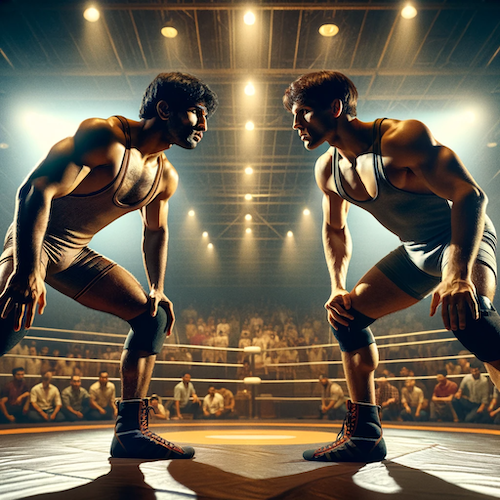
- Origin: 1878, Lancashire, England
- Main Techniques: Pinning, submission holds, catch-as-catch-can
- Popularity: United Kingdom, United States, Japan
Catch wrestling, or catch-as-catch-can, is a comprehensive grappling art with a rich lineage tracing back to 19th-century England.
It’s a precursor to modern mixed martial arts (MMA) and is characterized by its versatile no-holds-barred ethos and the ability to attack any part of the opponent’s body.
This style brings together the takedowns of traditional wrestling with the joint locks and chokes found in submission grappling, making it a formidable and complete combat system.
Historically, catch wrestling’s raw intensity and the inclusion of potentially dangerous techniques led to its exclusion from the Olympics post-1920, necessitating the sport to evolve into what is now recognized as freestyle wrestling.
Catch wrestling’s influence is evident in the development of professional wrestling, which originated from catch wrestling exhibitions and later incorporated theatrical and entertainment elements.
Today, catch wrestling continues to influence training regimens in various combat sports, from professional wrestling to MMA, underscoring its enduring legacy and effectiveness.
11. Freestyle Wrestling
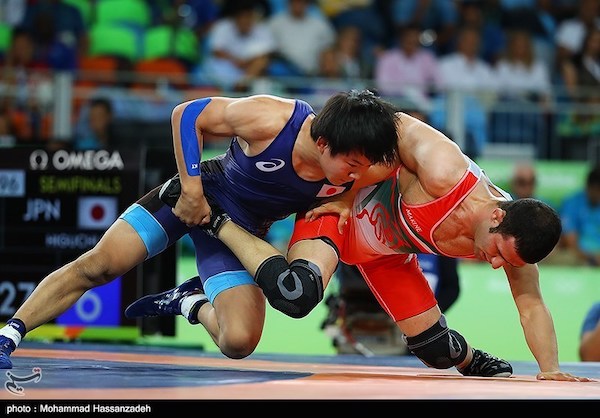
- Origin: Late 19th century, USA, Britain
- Main Techniques: Takedowns, exposures, lifts
- Popularity: Worldwide, especially in countries participating in the Olympics
Freestyle wrestling has been an Olympic sport since 1904 and is known for its high-energy matches and technical versatility.
Wrestlers employ a full range of movements, using both legs and arms for attack and defense, aiming to pin their opponent’s shoulders to the mat for an immediate victory.
Originating from catch-as-catch-can wrestling, freestyle incorporates techniques from judo and sambo, with a scoring system rewarding takedowns, control, and back exposure.
Unlike folkstyle wrestling, which emphasizes escaping from holds, freestyle focuses on preventing being turned when in a disadvantaged position.
Despite a brief threat to its Olympic status, freestyle wrestling remains a global phenomenon, thanks to the wrestling community’s advocacy.
12. Folkstyle Wrestling (Collegiate Wrestling)
- Origin: Early 20th century, USA
- Main Techniques: Takedowns, escapes, reversals, riding time
- Popularity: Primarily in the United States
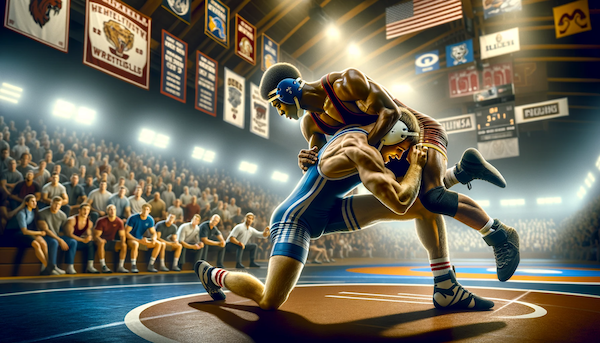
Folkstyle wrestling, also known as collegiate wrestling, is a wrestling style embodying the competitive spirit of American sports.
Originating in the early 20th century, it has become a staple in high schools and universities, forming the foundation of wrestling education in the United States.
Folkstyle wrestling is distinctive for its emphasis on control and maintaining dominance, with a unique scoring system that rewards near-falls and riding time, reflecting the wrestler’s ability to dominate their opponent.
The essence of folkstyle wrestling lies in not just pinning the opponent but controlling them throughout the match, which is integral to scoring and strategy.
Wrestlers engage in a tactical battle to escape, reverse, and outmaneuver their opponents, making it a dynamic and engaging sport for participants and spectators alike.
Regulated by the NCAA, its cultural significance is underscored by its popularity and the enthusiasm of collegiate wrestling events, often broadcasted nationwide.
13. Professional Wrestling

- Origin: 1920s, United States of America
- Main Techniques: Acrobatic maneuvers, slams, throws, use of foreign objects
- Popularity: Worldwide but mostly in the USA
Professional wrestling is a form of entertainment combining athletics with theatrical performance.
It’s characterized by scripted matches where the outcomes are predetermined and the performances are choreographed.
Wrestlers take on personas and engage in feuds and storylines designed to entertain and engage the audience.
Here are some key points about professional wrestling:
Scripted Performances: Unlike competitive sports, the matches in professional wrestling are prearranged to present an entertaining narrative.
Wrestlers play characters, often heroes or villains, in storylines that may last for months or even years.
Athleticism and Theatrics: Wrestlers are both athletes and performers, many of whom take steroids and build huge amounts of muscle for the role.
They execute complex moves that require physical skill and training, and they also act to convey their character’s persona and emotions.
Global Appeal: Professional wrestling has a worldwide fanbase, with promotions like WWE (World Wrestling Entertainment) being known globally.
Different regions have their own styles and promotions, such as New Japan Pro Wrestling and Mexico’s Lucha Libre.
Risks Involved: Despite being scripted, professional wrestling is physically demanding and can be risky. Wrestlers often suffer injuries due to the nature of their performances.
Training: Professional wrestlers train in various wrestling techniques and must develop their acting and performance skills to succeed in the industry.
Popularity: Professional wrestling is a significant part of popular culture, with wrestlers often crossing over into mainstream media and becoming celebrities in their own right.
14. Sambo
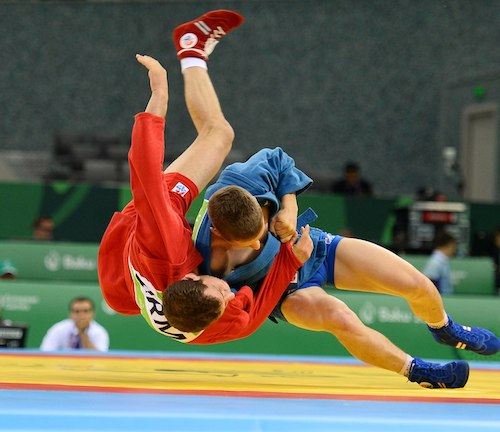
- Origin: 1920s, Soviet Union, Russia
- Main Techniques: Throws, joint locks, ground control
- Popularity: Russia, Eastern Europe, and gaining worldwide
- Founders: Viktor Spiridonov and Vasili Oshchepko
Sambo is a Russian martial art established in the 1920s. It’s a dynamic combination of judo, wrestling, and regional fighting techniques.
It’s split into Sport Sambo, which mirrors judo with an emphasis on throws and submissions, particularly leg locks, and Combat Sambo, which incorporates striking, reflecting its military origins for comprehensive self-defense.
Developed by the Soviet Red Army to amalgamate the most effective combat techniques, sambo’s practicality and adaptability have made it a staple in international martial arts.
Officially recognized in 1938, sambo has evolved into a key discipline in mixed martial arts, with many of the best Russian UFC fighters having extensive sambo backgrounds.
15. Beach Wrestling
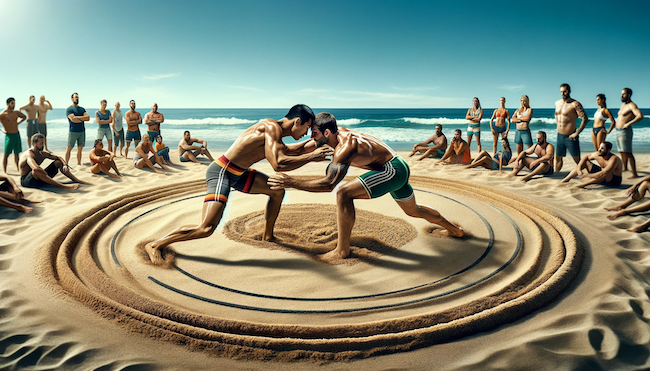
- Origin: 2005 (formalized), Ancient (informal practice), International Popularity
- Main Techniques: Takedowns, throws
- Popularity: Worldwide, with international competitions under United World Wrestling
Beach wrestling is a form of wrestling that has been officially recognized and held since 2005.
It’s a sport in which both men and women can participate, competing in a sand-filled circle with a diameter of 7 meters.
Unlike traditional wrestling, participants wear swimsuits or sports shorts instead of standard wrestling attire.
The sport underwent a significant rule change in 2015 by the International Federation of United World Wrestling (UWW). Now, wrestlers can score points by knocking an opponent down, out of the ring, or onto their back.
Beach wrestling requires strength, agility, and strategy, as matches are dynamic and take place on the unstable surface of sand, which adds an extra layer of challenge.
The competition is intense but brief, lasting only three minutes in a standing position without breaks.
Wrestlers can use their legs for scoring against the opponent and can put one knee down to perform actions. If a wrestler scores three or more points, the match can end earlier than the allotted time.
In the case of a tie, the last wrestler to score is declared the winner, or if there’s no score, the lighter wrestler wins.
Beach wrestling has gained international recognition, featuring in events like the Youth Olympic Games, Asian Games, Mediterranean Games, and the 2019 World Beach Games.
The World Beach Wrestling Championships have been held annually since 2019, showcasing the sport’s growing popularity and its appeal as a global competitive activity.


